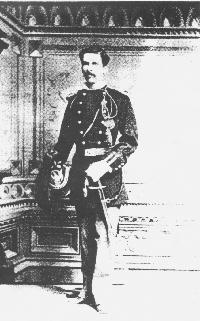Part II
by Guy A. Bigelow, Green Valley AZ

Lt. Col. John 8 Bigelow, son of John7, (Asa6, David5, David4, John3, Joshua2, John1)
From the Introduction to On the Bloody Trail of Geronimo:

"The discovery of gold and silver in the Prescott
region during the early 1860's brought hundreds of prospectors and miners
into that section and there were inevitable conflicts between the Indians
and the white interlopers. As usual, the white men held that the tribes had
no rights as human beings. Indians, particularly the Apaches, were only animals
in human form and as such were hunted and slain like animals.
The 12 February 1870 Tucson Weeklv Arizonan had
this news item: ON EXHIBITION: The scalp of the Indian killed by Col. Barnard,
upon whom was found Col. Stone's gold bar, is on exhibition at Charley Brown's
Saloon. The hair is glossy and beautiful and the ears are decorated by pendant
brass buttons.'
From the editorial page of the Pinal Arizona Sentinel,
25 June 1887: 'C. W. Pulver of Pinal has inaugurated a movement that ought
to be received with favor by the people of every county in the Territory.
Re is circulating for signatures an agreement by which the signers pledge
themselves to pay one dollar each for each Apache Indian killed by either
soldier or civilian, the limit to be one hundred such assessments. It is
believed (enough signatures can be obtainedi to swell the bounty upon each
scalp to $500 or possibly $1000. This method will bring in scalps and no
impertinent questions will be asked as to how they are obtained. It promises
some little compensation for the risk of hunting down savages and if it succeeds
in making a larger number of 'good Indians' (i.e. the only good Indian is
a dead Indian) than are supposed to be raiding the country, no particular
harm will be done.'
With such hatred of the Apache engendered by the
public press over the years, one need not wonder that the Indians retaliated
in kind whenever the opportunity presented itself. Gradually, however, the
military' began to get the upper hand."
Prior to the arrival of the Tenth Cavalry, hostile Indian activity was again
on the rise in Arizona and, particular, small bands of Chiricahua Apaches
were leaving the reservations and stirring up trouble. Earlier successful
carnpaigning by the army under the command of General George Crook had driven
the majority of the Apaches onto the reservations at San Carlos and Ft. Apache,
but now there were increasingly many renegade bands at large.
General Crook believed that the Apaches, if treated
fairly and made self-sustaining on the reservations, would, in time, become
good citizens. There were, however, malcontents who slipped away from the
agencies and stirred up trouble. Likewise, there were white men whose greed
for a few extra dollars obtained by short changing the captive Indians on
their rations, clothing, tools and forage, and selling them rot-gut whiskey,
led to serious consequences...
A grand jury investigation, at Tucson, of the conditions
at the San Carlos Indian Agency in October 1882, established the fact that,
to quote Capt. John Bourke, "fraud, speculation, conspiracy, plots and counterplots
seem to be the rule of action on this reservation. The grand jury little
thought when they began this investigation that they were about to open a
Pandora's box of iniquities seldom surpassed in the annals of crime. With
the immense power wielded by the civilian indian agent, almost any crime
is possible. There seems to be no check upon his conduct."
General Crook believed implicitly in his plans for
fair and just treatment in the management of the Indian tribes. After struggling
to implement his policies for many years, however, General Crook, unable
to reconcile his word of honor with the deceit and treachery implied by headquarters'
instructions to capture and kill all the hostiles, took the only way out
of his dilemma and requested a transfer from the Department of Arizona. Geronimo,
chief of the Apaches, at this point decided to run with his band when he
learned that Crook, the only high Government leader that had proved trustworthy,
was leaving.
The army in Arizona Territory, commanded by General
Crook's successor, General Nelson Miles, finally forced Geronimo's surrender
and on 8 September 1886, the U.S. exiled him and his band to Florida as prisoners
of war.
Sources:
Forge: The Bigelow Society Quarterly; Vol 27, No 3, July
1998, pg 49;
Back to main page: John8a.htm

